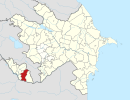Julfa District
Julfa District | |
|---|---|
UTC+4 (AZT) | |
| Postal code | 7200 |
| Website | culfa-ih |
Julfa District (
History
Established in 1930 and initially named Abragunus, it has been called Julfa District since 1950.[3] The names, Jolfa/Julfa are also used for several regions in neighboring Iran.
On November 28, 2014, by the decree of the
Geography
The district borders
Population
Compared to 1980, at the beginning of the 2005 the district's population increased of about 13,177 people or a 52.4%. On average density per 1 km2 is 39 persons. Its large settlements are the Julfa city and the villages of the
| Region | 2000 | 2001 | 2002 | 2003 | 2004 | 2005 | 2006 | 2007 | 2008 | 2009 | 2010 | 2011 | 2012 | 2013 | 2014 | 2015 | 2016 | 2017 | 2018 |
|---|---|---|---|---|---|---|---|---|---|---|---|---|---|---|---|---|---|---|---|
| Julfa region | 36,4 | 37,0 | 37,5 | 38,0 | 38,3 | 38,8 | 39,3 | 39,7 | 40,4 | 41,0 | 41,6 | 42,6 | 43,5 | 44,5 | 45,5 | 45,1 | 45,6 | 46,1 | 46,4 |
| urban population | 10,3 | 10,6 | 10,8 | 10,7 | 10,8 | 11,1 | 11,1 | 11,2 | 11,6 | 11,7 | 11,9 | 12,3 | 12,5 | 12,7 | 12,9 | 13,0 | 13,1 | 13,2 | 13,3 |
| rural population | 26,1 | 26,4 | 26,7 | 27,3 | 27,5 | 27,7 | 28,2 | 28,5 | 28,8 | 29,3 | 29,7 | 30,3 | 31,0 | 31,8 | 32,6 | 32,1 | 32,5 | 32,9 | 33,1 |
Cultural heritage
On the banks of the Araz River are remains of structures belonging to the medieval Armenian settlement of Jugha, also known as Old Julfa. Its principle monument, a cemetery containing some 4000 grave markers, was completely destroyed in 2006. Believed to be still surviving are the ruins of a 13th-century caravanserai - one of the largest on the territory of Azerbaijan, and the ruins of a bridge dated to the beginning of the 14th century, built by decree of Nakchivan Khan Khakim Ziya Ad-Din. There is the small Gulustan Mausoleum (13th century) near the village of Gülüstan and more mausoleums near the village of Darkənd (particularly well preserved is the Tower Mausoleum (15th century). Further inland from the river there is the fortress of Alindzha (12th-13th centuries) and a number of other monuments and ancient ruins.[9]
References
- ^ "İnzibati-ərazi vahidləri" (PDF). preslib.az. Retrieved 28 February 2021.
- ^ a b "Population of Azerbaijan". stat.gov.az. State Statistics Committee. Retrieved 22 February 2021.
- ^ ISBN 5-8066-1468-9.
- ^ "Milli Meclis". meclis.gov.az.
- ^ "Julfa". discoverazerbaijan.az. Archived from the original on 2013-09-02.
- ^ a b "Political division, population size and structure: Population by towns and regions of the Republic of Azerbaijan". The State Statistical Committee of the Republic of Azerbaijan. Retrieved 2018-12-18.
- ^ "Political division, population size and structure: Population by sex, towns and regions, urban settlements of the Republic of Azerbaijan at the beginning of the 2018". The State Statistical Committee of the Republic of Azerbaijan. Retrieved 2018-12-18.
- ^ "Political division, population size and structure: Population at age 14-29 by towns and regions of the Republic of Azerbaijan at the beginning of the 2018". The State Statistical Committee of the Republic of Azerbaijan. Retrieved 2018-12-18.
- ^ "Nakhchivan Autonomous Republic". nakhchivan.preslib.az.

